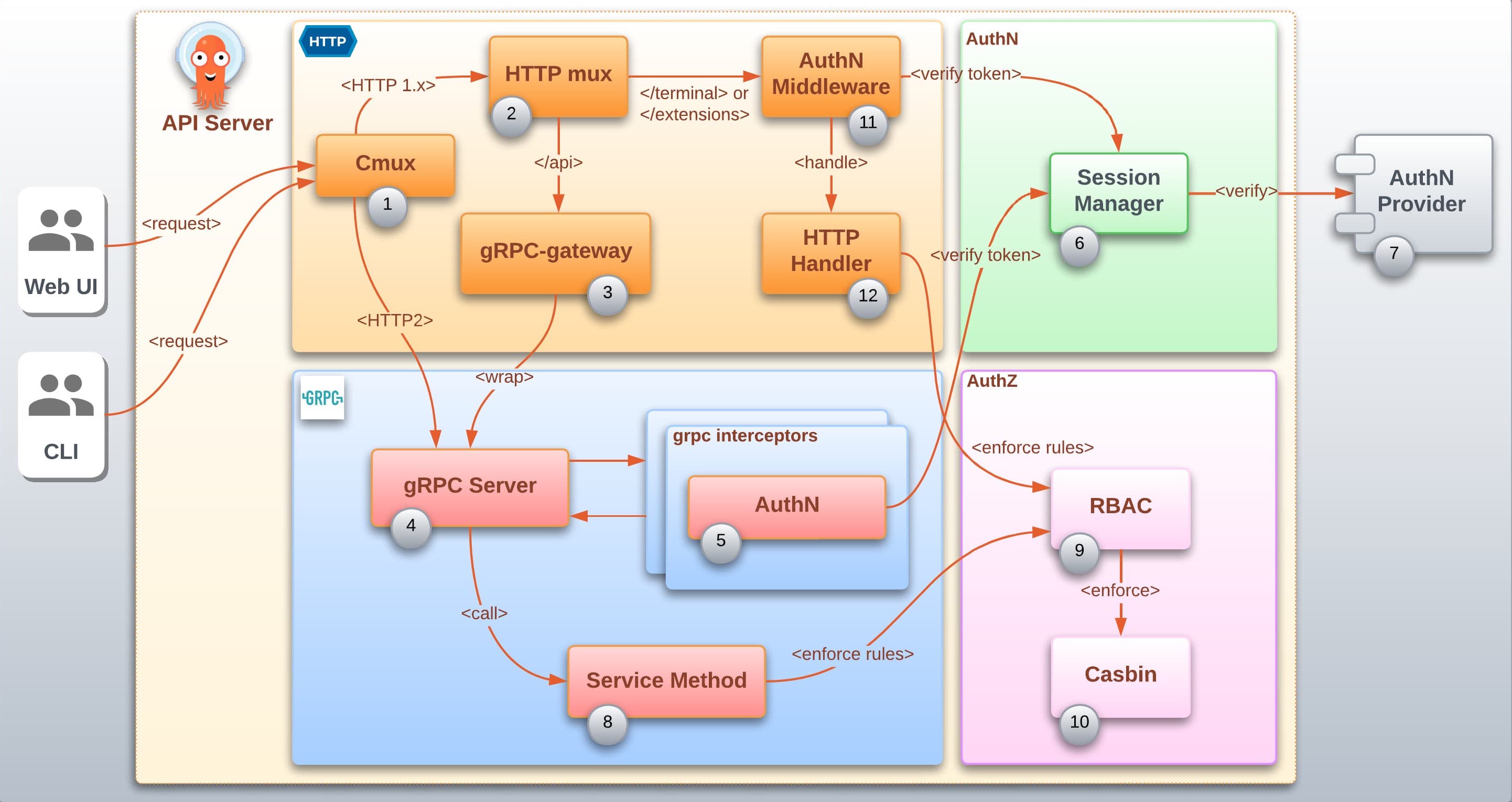Authentication and Authorization¶
This document describes how authentication (authn) and authorization (authz) are implemented in Argo CD. There is a clear distinction in the code base of when and how these two security concepts are enforced.
Logical layers¶
The diagram bellow suggests 4 different logical layers (represented by 4 boxes: HTTP, gRPC, AuthN and AuthZ) inside Argo CD API server that collaborate to provide authentication and authorization.
HTTP: The HTTP layer groups the logical elements that collaborate to handle HTTP requests. Every incoming request reaches the same HTTP server at the same port (8080). This server will analyze the request headers and dispatch to the proper internal server: gRPC or standard HTTP.
gRPC: The gRPC layer groups the logical elements responsible for the gRPC implementation.
AuthN: The AuthN represents the layer responsible for authentication.
AuthZ: The AuthZ represents the layer responsible for authorization.

Logical elements¶
The logical elements (identified by numbers) can represent an object, a function or a component in the code base. Note that this particular distinction is not represented in the diagram.
Incoming requests can reach Argo CD API server from the web UI as well as from the argocd CLI. The responsibility of the represented elements are described below with their respective numbers:
Cmux: Uses the cmux library to provide a connection multiplexer capability making it possible to use the same port to handle standard HTTP as well as gRPC requests. It is responsible for inspecting incoming requests and dispatch to appropriate internal servers. If the request version is
http1.xit will delegate to the http mux. If the request version ishttp2and has the headercontent-type: application/grpc, it will delegate to the gRPC Server.HTTP mux: A standard HTTP multiplexer that will handle non gRPC requests. It is responsible for serving a unified REST API to the web UI exposing all gRPC and non-gRPC services.
gRPC-gateway: Uses the grpc-gateway library to translate internal gRPC services and expose them as a REST API. The great majority of API services in Argo CD are implemented in gRPC. The grpc-gateway makes it possible to access gRPC services from the web UI.
Server: The internal gRPC Server responsible for handling gRPC requests.
AuthN: Is responsible for invoking the authentication logic. It is registered as a gRPC interceptor which will automatically trigger for every gRPC request.
Session Manager: Is the object responsible for managing Argo CD API server session. It provides the functionality to verify the validity of the authentication token provided in the request. Depending on how Argo CD is configured it may or may not delegate to an external AuthN provider to verify the token.
AuthN Provider: Describes the component that can be plugged in Argo CD API server to provide the authentication functionality such as the login and the token verification process.
Service Method: represents the method implementing the business logic (core functionality) requested. An example of business logic is:
List Applications. Service methods are also responsible for invoking the RBAC enforcement function to validate if the authenticated user has permission to execute this method.RBAC: Is a collection of functions to provide the capability to verify if the user has permission to execute a specific action in Argo CD. It does so by validating the incoming request action against predefined RBAC rules that can be configured in Argo CD API server as well as in Argo CD
ProjectCRD.AuthN Middleware: Is an HTTP Middleware configured to invoke the logic to verify the token for HTTP services that are not implemented as gRPC and requires authentication.
HTTP Handler: represents the http handlers responsible for invoking the business logic (core functionality) requested. An example of business logic is:
List Applications. Http handlers are also responsible for invoking the RBAC enforcement function to validate if the authenticated user has permission to execute this business logic.


No comments:
Post a Comment